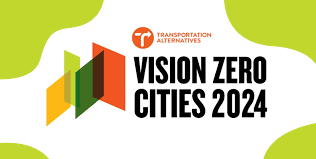Double lines are standard on roadways, but double standards are also channeling our path when it comes to road safety.
Here’s the connection: for more than 25 years “Vision Zero’, a traffic safety program that originated in Sweden has aimed to achieve no fatalities or serious injuries on the road. The objectives are openly praised. But despite the rhetoric, Vision Zero has saved few lives, at least here in the United States. In 1995 there were 41,817 total deaths that involved vehicles, pedestrians, bikes, and motorcycles on the roadways and the number increased to 42,939 in 2021. (In interpreting the FARS data base observe that the number of drivers and the distance they travel may be increasing)
When I first learned about Vision Zero during a civic presentation, I expected that the speaker would give a nod to future autonomous vehicles. She did not. The paradox is that roughly since 1995, when Vision Zero started, engineers have been working on and improving driverless technology. Today, with a few hiccups, and no fatalities in recent years, driverless vehicles operate in San Francisco, Phoenix, and other cities. Cruise LLC, an operator, expects to return to San Francisco after their vehicle struck a pedestrian and the company misreported it.
Learning Steps:
The Cruise accident generated heat and public outcry, but fortunately the pedestrian has survived with injuries. When you read the details of this multi-part collision it’s not evident that having a human driver behind the wheel would have led to a better outcome. Still, temporarily removing the Cruise vehicles from the streets is a step forward for both safe driving and for Vision Zero. Each incident forces an investigation. Learning from the occasional accident is vital- it is similar to the way that the Federal Aviation Authority (FAA) has protocol following an airplane crash to discover and rectify the issues.
Autonomous vehicles are carefully recorded but efforts in the Vision Zero toolbox are more of a scattershot. There is no guaranteed path to saving lives, with the notable exception of reducing (and enforcing) speed limits. Traffic engineers try different methods from eliminating street parking to improving lighting. These are each helpful, but they are different from ones that that would make roads safer for all vehicles, including autonomous vehicles that might operate alongside conventional ones.
Going Backwards:
Second, we should remind vehicle car manufacturers that they are producing vehicles that undermine the goals of Vision Zero. Since that program began in the late 1990s, vehicles have bulked out. The current showroom has pickup trucks and full-sized SUVs that weigh more, are higher off the ground, and have significantly taller hoods. Their bulk makes them more dangerous to pedestrians and bikers. Apparently, it is the height of the hood that is often lethal. The design leads to a human blind spot, much as the ill-fated Cruise vehicle in San Francisco experienced a blind spot in its sensors.
Third, there is a confusion in the public mind about road safety because they conflate the accidents taking place in Tesla driver-assist vehicles with the driverless vehicles operated by Waymo and Cruise. The software in Tesla vehicles goes by many names, like self-driving, autopilot, and remote steering. In view of the accident rate, and even fatalities, Tesla has begun to roll back claims that its technology is foolproof.
Rigorous Data:
Meanwhile, Waymo (Google) analyzed results from autonomous vehicle trials in San Francisco, Phoenix, and Los Angeles and compared the data to human driving benchmarks. Their findings indicate that the driverless cars had an 85 percent reduction in injuries, compared with human driven vehicle trips. Over the 7 million plus miles the vehicles covered there were only three crashes that resulted in injuries, and none of them involved fatalities. In a separate study, Waymo engineers simulated various human-driven crashes. The self-driving cars would have led to zero or no deaths, and the vehicles would have avoided most of the crashes.
If planners and government officials are truly serious about Vision Zero then they need to consider the data, logged from millions of miles on the road. Over the past twenty five years there have been improvements in road design too yet the changes have been undone by things like larger vehicles, less speed enforcement, and increasing levels of cell phone usage in cars. Until driverless vehicles are recognized as complements, Vision Zero is a distraction and traffic deaths and accidents will continue to mount.

